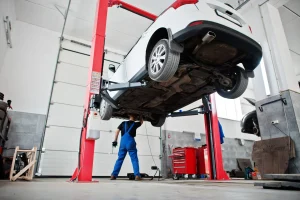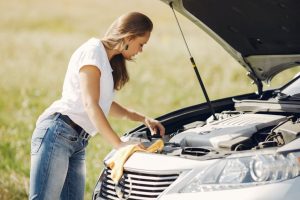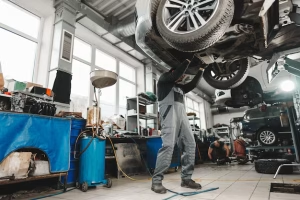Fixing your car might seem intimidating at first, but with the right knowledge and tools, it’s easier than you think. More drivers are turning to DIY car repair to save time, money, and help the environment. Whether you’re a busy commuter, a car enthusiast, or someone aiming to reduce their environmental footprint, understanding the basics of car maintenance puts you in control.
This beginner’s guide will take you through common car issues, the telltale symptoms to watch for, straightforward DIY repair techniques, and maintenance tips to keep your vehicle running smoothly and sustainably. By the conclusion, you’ll feel empowered to handle everyday car mishaps with confidence.
Common Car Issues and Their Symptoms
Noticing something unusual with your car but not sure where to begin? Spotting the symptoms early is key to addressing issues before they escalate. Here are four common car problems and the signs to keep an eye on:
1. Flat Tire
Symptoms to watch for:
- A sudden thudding sound or vibration when driving.
- Difficulty steering.
- A visibly deflated or damaged tire.
Flat tires are one of the most frequent car problems drivers face, often due to nails or sharp debris on the road. Left unchecked, a flat tire can lead to further damage to your wheel or even an accident.
2. Dead Battery
Symptoms to watch for:
- Engine won’t crank, or there’s a clicking sound when you turn the ignition.
- Dim interior or dashboard lights.
- Electrical systems like the radio failing to work.
Batteries can die for simple reasons, like leaving the headlights on, corrosion on the terminals, or simply an old battery nearing the end of its life.
3. Overheating Engine
Symptoms to watch for:
- Engine temperature gauge rising to the red zone.
- Steam (or what looks like smoke) coming from under the hood.
- A sweet, burning odor from the car’s engine.
Failure to address an overheating engine can result in severe and costly damage, such as a cracked engine block.
4. Strange Engine Noises
Symptoms to watch for:
- Knocking or ticking sounds inside the engine.
- Squealing when the car starts, accelerates, or brakes.
- Hissing or popping noises under the hood.
These noises can indicate anything from loose components to fuel-related issues. Ignoring them may lead to poor engine performance or outright failure.
Armed with this knowledge, you’re ready to tackle some of these issues head-on.
DIY Repair Techniques
Sometimes all it takes is a little guidance to fix a car issue yourself. Mastering these foundational repairs will save you money on labor costs and wasted time at the shop.
1. How to Change a Flat Tire
Tools Needed: Spare tire, lug wrench, car jack, wheel wedges
- Find a safe, flat surface to pull over and park your car.
- Place wheel wedges behind your tires to stabilize the vehicle.
- Loosen the lug nuts on the flat tire (don’t remove them yet).
- Use the car jack to lift the car so the flat tire is off the ground.
- Remove the lug nuts and take off the flat tire.
- Align the spare tire onto the wheel bolts and hand-tighten the lug nuts.
- Lower the car and tighten the lug nuts securely with the wrench.
2. How to Jump-Start a Car
Tools Needed: Jumper cables and another car with a working battery
- Position the car with the working battery close to your car with the dead battery, but make sure they don’t touch.
- Connect the red clamp to the positive terminal of the dead battery, and the other red clamp to the positive terminal of the good battery.
- Attach the black clamp to the good battery’s negative terminal, and the other black clamp to an unpainted metal surface on your car.
- Start the engine of the working car, then your car.
- Once your car starts, carefully remove the clamps in the reverse order.
3. Addressing an Overheating Engine
Steps to Take:
- Turn off your air conditioner and, if safe, pull over immediately.
- Turn on the heater to divert heat away from the engine.
- Check your coolant levels once the engine cools down (never open the radiator cap when the engine is still hot).
- If coolant levels are low, refill with coolant or water as a temporary fix.
4. Diagnosing Strange Engine Noises
- Knocking: Check your oil levels. Low oil is a common culprit.
- Squealing: Inspect the drive belt and brakes for wear. Replace them if necessary.
- Hissing or popping: Examine hoses for leaks or cracks.
Car Maintenance Tips for the Eco-conscious Driver
Caring for your car doesn’t just keep it performing well—it reduces its carbon footprint and helps the planet. Here’s how eco-conscious drivers can maintain their vehicles sustainably.
1. Regular Checks Matter
- Tires: Ensure tire pressure is optimal. Under-inflated tires consume more fuel.
- Fluids: Check and top up engine oil, brake fluid, and coolant regularly.
- Battery: Look for signs of corrosion and clean the terminals frequently.
2. Choose Eco-friendly Products
- Opt for biodegradable soaps when washing your car.
- Avoid cleaners with VOCs (volatile organic compounds) to minimize air pollution.
3. Drive Gently
Aggressive driving, such as sudden acceleration and braking, consumes more fuel. Smooth driving not only saves gas but reduces wear and tear.
4. Explore Tire Recycling
When replacing worn-out tires, look for recycling programs in your area to ensure proper disposal. Recycling prevents chemical pollutants from affecting the environment.
Gain Confidence and Save Money with DIY Repairs
Being able to fix common car problems and maintain your car efficiently is empowering. Not only will you save money and time, but you’ll also reduce your environmental footprint while enhancing safety on the road.
The road to confident DIY car repair begins with these steps, but it doesn’t have to end here. Keep learning, experiment with new techniques, and don’t shy away from sharing your experiences with others.
Have an inspiring or funny DIY car repair story to share? Or a question about tackling specific issues? Leave a comment below—our community of car enthusiasts would love to hear from you!


